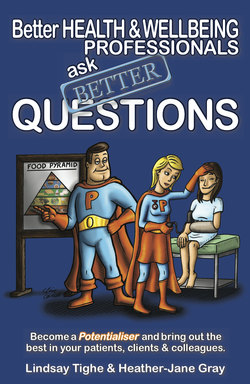Читать книгу Better Health & Wellbeing Professionals Ask Better Questions - Lindsay Tighe - Страница 10
Chapter 1 Different hats
ОглавлениеIn your role as a Health & Wellbeing Professional, we’re certain that you feel as if you have to wear many different hats; sometimes it feels like you have to wear many hats at the same time! We believe that the essential skill of being effective in your role is knowing which is the right hat to wear, at the right time and in the right way, to best deal with the situation being faced. This choice is rarely straightforward, particularly when you are under pressure and juggling many priorities at the same time, as well as not really knowing what approach will give you the desired results. In addition, there is the added complication of having to deal with people’s different personalities, backgrounds and cultures, which mean being able to best respond to their different perspectives, mindsets and preferences.
When it comes to people, there is never a ‘one size fits all’ approach to problems – we have to respond intuitively to situations that, on the surface, appear to be the same, but often require a different approach because of the challenge of dealing with the unique qualities of people. We’ve found that trying to work effectively with diversity generally has brought us the most challenges, as well as the greatest joy and rewards (with every emotion in between!). We both love the fact that there are rarely any easy answers.
Deciding what is the right hat to wear (i.e. what our response should be to a certain situation or person) is often not straightforward and so typically our first response is often made in a habitual way that is easiest for us and fits within our comfort zone. From what we’ve shared with you so far, you’ll probably acknowledge that many people feel most comfortable, not surprisingly, with the ‘teller’ response. This is the hat that they will bring to their professional roles – on automatic pilot in many instances. This can be particularly true due to the traditional medical hierarchy in many health and social care settings.
What we’d like to do to start to build a strong case for asking Better Questions is to share some insights into the most frequent hats we wear in our lives generally. We hope that by doing this you’ll be able to recognise the key aspects of each hat in the hope that, going forward, it will help you to make more informed choices rather than automatic responses.
So, to start this exploration, we invite you to consider a line, with one end representing the more typical ‘telling’ space and the other end representing the ‘asking’ space.
We ask in advance for your understanding in the explanations we’re about to share with you, as they may at times appear to be simplistic in their nature. We recognise that rarely is anything clear-cut in life, and usually there are many grey areas; however, if you can bear with us we hope to be able to clarify some important points that will enable you to glean more understanding about the key distinctions between the two approaches of ‘telling’ and ‘asking’.
Let’s start by talking about some of the hats (roles) that we all relate to in life – especially the ones that belong more at the ‘telling’ end of our TELLER—ASKER line. We’re certain that you’ll relate to them in many aspects of your life and work, even if you don’t necessarily adopt the names that we’ve given them.
